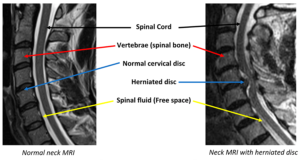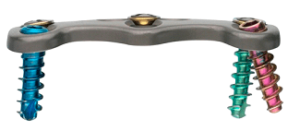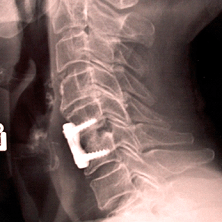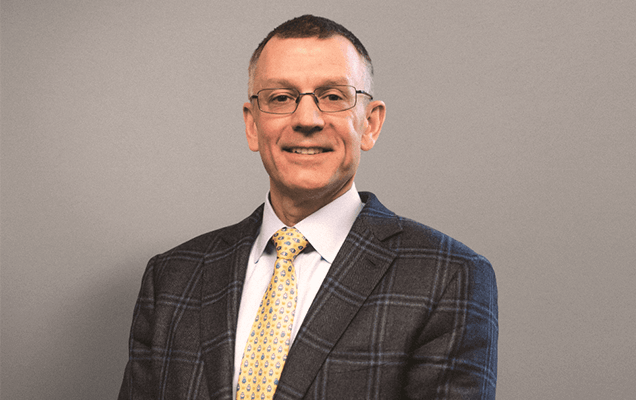General Overview
An anterior cervical discectomy and fusion (ACDF) is an operation performed in the cervical spine, aka neck area, to address degenerative disc disease.
The surgery is intended to widen the spinal canal by removing damaged cervical discs and/or bone spurs, releasing the spinal cord and spinal nerves. A fusion of the spinal vertebrae is then performed to stabilize the spine.
Who is a candidate for an ACDF
The cervical disc (AKA intervertebral disc) is made up of cartilage and acts like a cushion between the cervical bones, or vertebrae.
As the disc material degenerates, the disc space collapses creating bone spurs and possibly a herniated disc 1.

- The damaged disc can lead to pain involving the neck, shoulders, and/or shoulder blades.
- The bone spurs and/or herniated disc narrow the channels through which the spinal cord and spinal nerves travel, a condition known as spinal stenosis. Patients can present with a variety of symptoms due to spinal cord and spinal nerve compression 2:
- Arm pain, tingling, numbness, or weakness
- Loss of hand coordination
- Balance difficulty or gait instability
- Urinary urgency
A combination of physical therapy, medications, and possible spinal injections may be considered prior to surgery, particularly for complaints of neck pain 3. However, a patient presenting with a neurological deficit, numbness or weakness, may require surgery sooner to avoid permanent neurological injury 4. When deciding to pursue ACDF surgery, it is important to correlate the patient’s presentation to the findings on imaging (such as MRI or X-ray).
The decision to pursue an anterior cervical discectomy and fusion should only be considered after a thorough discussion with an experienced spine surgeon. The patient should have a thorough understanding of their condition and options and feel that the discussion is trustworthy and provides uniquely informative information.
How is an ACDF performed
The procedure is performed under general anesthesia. A skin incision is made in the front of the neck. The neck structures are separated by gentle dissection to provide a corridor to the spine.
An X-ray is obtained to confirm that the appropriate discs in the neck have been exposed. The disc is removed, the discectomy, along with any bone spurs to relieve pressure on the spinal cord and nerves. Once the disc space has been cleaned out, a bone graft is inserted to provide support and allow for solid bone growth, the fusion, between the vertebrae. The vertebrae are secured with the application of a metal plate and screws. The metal plate and screws has been shown to increase the success rate of the bone healing 5.

Anterior cervical plate and screws
Once the plate is in position, and X-ray is obtained in the operating room to ensure adequate placement. The retractors are removed and the neck structures simply fall back into place. The incision is closed with a single suture that is under the skin.

Postoperative X-ray of patient undergoing ACDF and with anterior cervical plate
What is it like after surgery
Following the procedure, patients will experience some swallowing discomfort due to retraction on the esophagus and may require softer foods for the first week or so following surgery.
There is usually minimal pain at the incision site. Depending on the strength of the patient’s bone, an external collar may or may not be needed to limit range of motion for the first 4-6 weeks after surgery. Patients can return home the same day or after an overnight hospitalization.
The healing process of the fusion can take several months. During this time however, most patients return to their normal activities. Although the fusion will reduce the range of motion of the involved neck area, for one- or two-level procedures, this motion limitation is rarely appreciated.
Under certain circumstances, the fusion aspect of the procedure can be avoided with the insertion of an artificial disc (see below).
Alternative to an Anterior Cervical Discectomy and Fusion
An ACDF procedure is considered a highly successful operation.
There are however alternatives to the spine fusion. A mechanical device can be inserted to replicate normal neck motion, known as an artificial cervical disc or arthroplasty 6. The procedure is essentially the same except the artificial disc replaces the bone graft in the disc space. Not every patient is a candidate for an artificial disc, therefore an experienced spine surgeon should be consulted if this option is considered.
Summary
Anterior cervical discectomy and fusion is a highly successful spine surgery when performed for the appropriate indications.
Patients can appreciate significant improvement in their quality of life. Through a comprehensive discussion with an experience, trusted spine surgeon, patients should feel completely comfortable with the decision to pursue surgery.
- Kaiser, M.G., Multilevel cervical spondylosis. Neurosurg Clin N Am, 2006. 17(3): p. 263-
75, vi. - Theodore, N., Degenerative Cervical Spondylosis. N Engl J Med, 2020. 383(2): p. 159-168.
- Cohen, S.P., Epidemiology, diagnosis, and treatment of neck pain. Mayo Clin Proc, 2015.
90(2): p. 284-99. - Matz, P.G., et al., Anterior cervical surgery for the treatment of cervical degenerative
myelopathy. J Neurosurg Spine, 2009. 11(2): p. 170-3. - Kaiser, M.G., et al., Anterior cervical plating enhances arthrodesis after discectomy and
fusion with cortical allograft. Neurosurgery, 2002. 50(2): p. 229-36; discussion 236-8. - Roberts, T.T., et al., Cervical Total Disk Arthroplasty. Clin Spine Surg, 2018. 31(1): p. 6-13.

About Dr. Michael G. Kaiser
Dr. Michael G. Kaiser is a nationally recognized neurosurgeon in North Jersey and is a proud member of Neurosurgeons of New Jersey, practicing out of their Ridgewood office conveniently located on East Ridgewood Avenue. Dr. Kaiser specializes in complex and minimally invasive spine surgeries.
Please call today to schedule a consultation with me.
(551) 284-3265
Request a consultation with Dr. Kaiser

